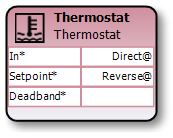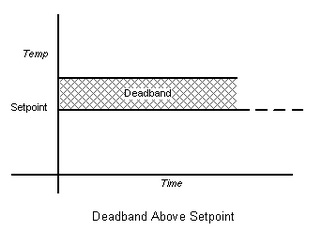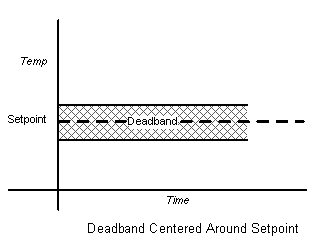
Controls digital heating or cooling by referencing an input to a setpoint.
A typical application of a thermostat control block is the control of a baseboard heater based on the difference between the measured space temperature and a setpoint.
The Thermostat programming block includes a deadband which can be positioned above, below, or centered on the setpoint.


Table 8: Effect of Deadband Type and Input Value on the Output Slots of the Thermostat programming block
Deadband Type |
Input Value |
Direct |
Reverse |
Above |
Greater than setpoint + deadband |
True |
False |
Above |
Less than setpoint |
False |
True |
Centered |
Greater than setpoint + ½deadband |
True |
False |
Centered |
Less than setpoint – ½deadband |
False |
True |
Below |
Greater than setpoint |
True |
False |
Below |
Less than setpoint – deadband |
False |
True |
Any setting |
Null |
Null |
Null |
Inputs |
|
|
|
|
|
Slots |
Type |
Default |
Description |
|
In |
Numeric |
Null |
The input monitoring the controlled condition. For example: the space temperature. A Null value causes the outputs to have a Null value. |
|
Setpoint |
Numeric |
Null |
The intended value of the controlled condition. For example: the intended space temperature. A Null value causes the outputs to have a Null value. |
|
Deadband |
Numeric |
|
The minimum difference between the monitored input (In) and the setpoint required to activate the output. |
Outputs |
|||
|
Slots |
Type |
Description |
|
Direct |
Digital |
The output is set to True when the input (In) is above the Setpoint. Otherwise the output is False. See ‘Deadband Type’ and Table 8. |
|
Reverse |
Digital |
Maintains the opposite value of the Direct slot. The output is set to True when the input (In) is below the Setpoint. Otherwise the output is False. See ‘Deadband Type’ and Table 8. |
Properties |
||
|
Slots |
Description |
|
Deadband Type |
The deadband can be configured in one of three ways: ‘Above’, ‘Below’, ‘Centered’. The configuration effects are shown in Table 8.
|